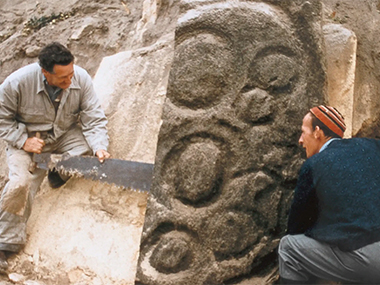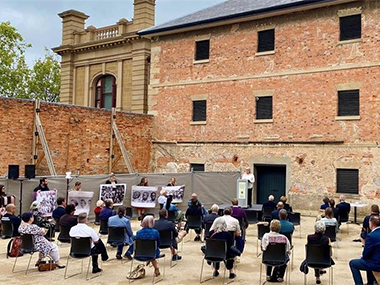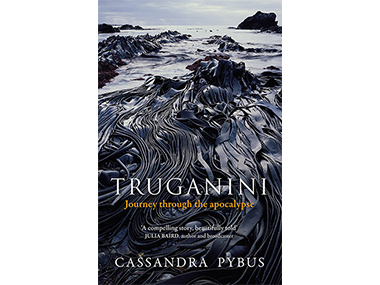lutruwita apology

The act of desecration - the Preminhana petroglyph is hacked from its ancient rock home
Posted by Jeremy Eccles | 19.02.21
Gallery: Tasmanian Museum and Art Gallery
I'm off to lutruwita tomorrow – though my flight will say it's going to Tasmania. Coincidentally, the Apple Isle has been in the news this week because an official apology was made to the First Peoples of lutruita about the disgraceful ethnological excesses in their treatment in the past, and the surprisingly recent theft of a 14,000 year old petroglyph from rocks in the far northwest region of the takayna/Tarkine.
I shall be visiting its bereft site at Preminghana/Mt Cameron West. Sadly, no one seems to be able to explain the import of its series of deeply incised circles.
On Monday, the Royal Society of Tasmania and the Tasmanian Museum and Art Gallery formally apologised to Tasmania's Aboriginal community over the mistreatment and theft of cultural artefacts. Monday's apology was part of a commitment to return the ancient petroglyphs to their original site at Preminghana which were taken in the 1960s, and given to TMAG in Hobart and the Queen Victoria Museum and Art Galley in Launceston.
The pieces that were taken to Hobart were displayed at the TMAG from 1967 until 2005. They have since been kept in storage.
Chair of the Tasmanian Aboriginal Land Council Michael Mansell said the petroglyphs would be returned to their original site in early March. Rock carvings by Tasmania's Aboriginal people can still be found on the state's north and south-west coast, depicting the lifestyle and significant events of the people. In 1995, the Tasmanian government returned 13 pieces of land back to the Aboriginal community. One of those pieces of land was the 540-hectare block of Preminghana. It has since been managed by the Tasmanian Aboriginal Centre.
Chair of the TMAG Board of Trustees, Ms Brett Torossi, said the apology was long overdue. "Today is a day of enormous importance and gravity," she said. "We apologise for over 200 years of practices that we acknowledge were morally wrong. We declare that such behaviour will never happen again".
It was a view echoed by the Royal Society President, Mary Koolhof: ‘The historical record shows very clearly that actions by past members of the Royal Society of Tasmania caused harm to the Aboriginal community. Aboriginal remains were exhumed by members of the Society, without regard for the cultural, spiritual and personal significance of those remains”.
The Tasmanian Royal Society dates back to 1843, making it the oldest in the country, and set about creating collections 'for the advancement of knowledge' from the beginning. In both Hobart and Launceston it became active in an international network providing collectors of Aboriginal cadavers around the world with skeletal remains acquired from gravesites.
“If you look at it like a ladder of world cultures”, senior research fellow at the University of Tasmania, Rebe Taylor explained, “Aboriginal people in Australia were seen as being at the bottom of the ladder, and the very bottom of all was Tasmanian [Aboriginal people]. They were seen as the simplest, most primitive people in the world, for various misguided reasons”.
Pro-Vice Chancellor of Aboriginal Leadership at the University of Tasmania and Aboriginal man, Greg Lehman said these two institutions “probably have more to apologise for than most institutions in Tasmania. They were involved in the most infamous and bizarre and macabre events in Tasmanian colonial history”. For instance, Aboriginal woman Truganini expressed her wish to be cremated at sea upon her death, but that didn’t happen. Instead, the Royal Society exhumed her body and put her skeleton on display in TMAG until 1947, when it was taken down. It wasn’t until 1976 that her wish was fulfilled – a century after she died.
URL: https://www.tmag.tas.gov.au/about_us/apology_to_tasmanian_aboriginal_people
Share this:
»  del.icio.us
»
del.icio.us
»  Digg it
»
Digg it
»  reddit
»
reddit
»  Google
»
Google
»  StumbleUpon
»
StumbleUpon
»  Technorati
»
Technorati
»  Facebook
Facebook
Contact Details
Gallery: Tasmanian Museum and Art Gallery
Contact: Tony Brown - Curator of Indigenous Cultures
Email: tmagmail@tmag.tas.gov.au
Telephone: +61 3 6165 7000
Address: Dunn Place or GPO Box 1164M Hobart TAS 7001 Hobart 7001 TAS

The apology ceremony in the courtyard at the Tasmanian Museum & Art Gallery

Cassandra Pybus's no-holds-barred biography of Truganini
Where is the exhibition?
Further Research
Gallery: Tasmanian Museum and Art Gallery
News Tags: Jeremy Eccles | lutruwita | Michael Mansell | petroglyphs | Tarkine | Tasmanian Museum & Art Gallery | Truganini
News Categories: Blog | Event | Feature | Industry | News | Other Event
Exhibition Archive
- 19.02.21 | National Endowment for Indigenous Visual Arts
- 11.01.21 | "Lost in Another Person's Culture”
- 04.01.21 | Appreciating Mparntwe
- 09.12.20 | Museological Sydney
- 02.12.20 | Getting Back into the Habit in Sydney
- 25.11.20 | VICTORIA OPENS!
- 17.11.20 | Aboriginal Art Storms Online
- 10.11.20 | 'Nilimurra Dhuwal: Here We Are' by Guynbi Ganambarr
- 06.11.20 | GORDON BENNETT SOLO IN QUEENSLAND
- 28.10.20 | The 'Seven Sisters' Heading for England
- 28.10.20 | $80K Across Seven Awards - The Big Telstra Open for Entries
- 13.10.20 | The Ebes Collection
- 12.10.20 | Sun Shines on the Wiradjuri Festival
- 06.10.20 | New Art Gallery to Open in Granville
- 25.09.20 | Archie Has First Aboriginal Winner
Advertising

